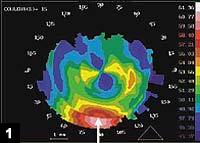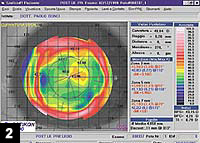Elliptical lamellar keratoplasty is a better method for treating eccentric keratoconus
A circular lamella is inserted into an elliptical pocket to avoid an irregular indentation in the corneal profile.
VENICE — When treating eccentric keratoconus with lamellar keratoplasty, an elliptical shaped keratectomy, rather than a circular one, should be performed to receive the donor graft. This technique, called elliptical lamellar keratoplasty, is a variation of the Buratto-Genisi differential thickness lamellar keratoplasty (DTLK) and was presented at the Venice 2000 meeting by Paolo Bonci, MD, head of Imola Eye Clinic.
“In DTLK, a round portion of corneal tissue is removed and replaced by a donor lamella of slightly larger diameter, which is inserted and sutured under the edges of the corneal circumference,” Dr. Bonci explained. This kind of grafting, he said, gives the best results when treating central keratoconus. A well applanated surface and a regular profile are obtained.
“However, problems arise when treating eccentric keratoconus. In this case, the peripheral ectasia pushes up on the lamella, causing an irregular indentation in the corneal profile,” Dr. Bonci said.
An elliptical ablation, a round lamella
 ---Circular lamellar keratoplasty for keratoconus after removal of sutures. Peripheral ectasia causes an indentation in the corneal profile (arrow).
---Circular lamellar keratoplasty for keratoconus after removal of sutures. Peripheral ectasia causes an indentation in the corneal profile (arrow).
When dealing with eccentric keratoconus, Dr. Bonci performs an elliptical ablation on the recipient cornea. He uses the excimer laser and a mask of appropriate size, according to the morphology, extension and position of the keratoconus. The longer axis of the ellipse must be perpendicular to the keratoconus axis. Under this ablated, elliptical hole, a round lamella is inserted.
“In this way, a larger portion of the round lamella is embedded under the cornea along the keratoconus axis, and a thinner rim is fixed under the cornea on the diametrically opposite axis.
“Along the keratoconus axis, which is the shorter axis of the ellipse, the lamella is secured, tighter and better stretched, and there is more pressure and more applanation,” Dr. Bonci explained.
As a final result, the corneal profile will be even and regular and the lamellar implant secured and stable under the elliptical hole.
Dr. Bonci treated 21 cases of eccentric keratoconus with this technique. The follow-up ranged from 3 to 8 months. Mean visual acuity at 6 months was 20/30.
A stable graft and a regular profile
 --- Elliptical lamellar keratoplasty for keratoconus after removal of sutures. Slight bow-tie central astigmatism can easily be treated with the excimer.
--- Elliptical lamellar keratoplasty for keratoconus after removal of sutures. Slight bow-tie central astigmatism can easily be treated with the excimer.
The different results of circular and elliptical lamellar keratoplasty in the treatment of eccentric keratoconus were illustrated by topographic maps (see figures 1 and 2).
“Two to three months after surgery, topographic patterns of circular lamellar keratoplasty often show a peripheral area of increased curvature, which is a bulge of the lamella over the underlying keratoconus. This new peripheral ectasia, which is smaller in size than the original one, tends to appear when the sutures are removed and the lamella is not held as tightly and stretched as it was before. While the sutures are in place, the maps show a neat, regular pattern,” Dr. Bonci explained.
In the majority of cases, however, the profile of the optical zone is sufficiently regular to guarantee a medium acuity of about 20/40.
At the same postoperative time, topographic patterns of elliptical lamellar keratoplasty showed a regular profile in the entire area. Even a few months after sutures had been removed, the lamella was secured and stable in its pocket. The peripheral area appeared as a continuous blue ring of 360°, indicating a uniform applanation of the cornea. Centrally, the profile was regular.
“In the worst of cases, a symmetric bow-tie pattern could be observed, indicating a regular astigmatism ranging from 2 to 6 D, which could easily be treated with the excimer laser after refractive stability had been achieved,” Dr. Bonci said. “The mean visual acuity of our patients was 20/30, indicating that a more regular corneal profile was achieved.”
For Your Information:
- Paolo Bonci, MD, can be reached at Divisione Oculistica Ospedale Civile S. Maria della Scaletta, Via Montericco 6, Imola (RA), Italy; +(39) 335-8422230; fax +(39) 0544-34368.
